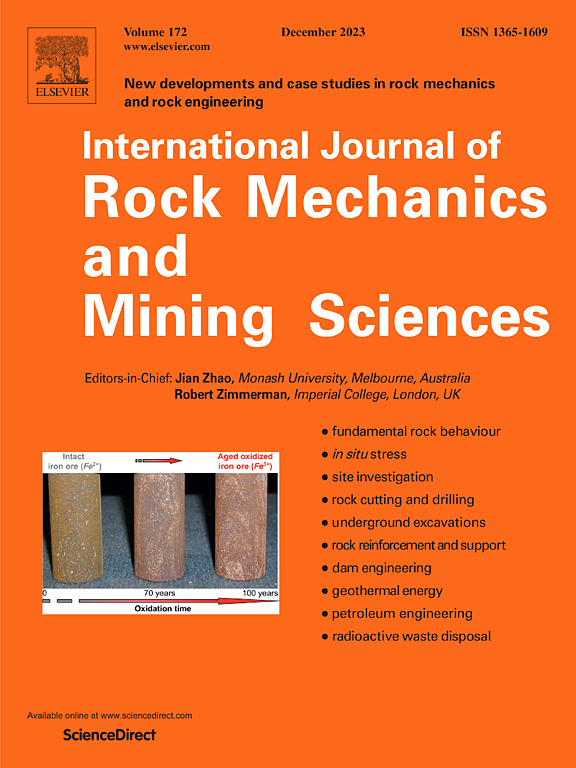Radiation efficiency and acoustic efficiency in rock cracking: a new understanding from low and high frequency waveforms
IF 7
1区 工程技术
Q1 ENGINEERING, GEOLOGICAL
International Journal of Rock Mechanics and Mining Sciences
Pub Date : 2025-04-25
DOI:10.1016/j.ijrmms.2025.106129
引用次数: 0
Abstract
The application of acoustic emission (AE) techniques can capture the formation of discontinuities during crack propagation. Although the received waveforms exhibit significantly different frequency spectrum, the high and low frequency components are usually not separately examined and processed. In addition, the radiation efficiency and acoustic efficiency in acoustic radiation are not well analysed in brittle failure. This study proposed an AE waveform separation based on the frequency response. The acoustic radiation energy showed that P waves account for 0.0137 % and S waves 0.0433 % of the total input energy. However, the allocation of S wave energy between high and low frequency waveforms indicated the occurrence of shear microcracks in tensile crack propagation. The high frequency events were found to more likely be energetic events, featuring a similar profile to foreshocks before earthquakes. This likely results from energy dissipation due to shear microcracking friction The acoustic efficiency was observed to remain nearly independent of frequency and failure mechanisms, following a log-normal distribution. In conclusion, this study revealed a new relationship between acoustic emissions and crack propagation in brittle materials. The results suggest that the ground damage generated by a tensile earthquake could be more destructive than that by a same level shear earthquake owing to a higher percentage of energy radiation. This could be particularly important in the mine earthquake risk assessment.
岩石开裂的辐射效率和声效率:从低频和高频波形的新认识
应用声发射技术可以捕捉裂纹扩展过程中不连续面的形成过程。虽然接收到的波形表现出明显不同的频谱,但通常不单独检查和处理高频和低频分量。此外,在脆性破坏条件下,声辐射的辐射效率和声效率还没有得到很好的分析。本文提出了一种基于频率响应的声发射波形分离方法。声辐射能量表明,P波和S波分别占总输入能量的0.0137%和0.0433%。然而,S波能量在高低频波形之间的分配表明,拉伸裂纹扩展过程中存在剪切微裂纹。研究发现,高频事件更有可能是高能事件,其特征与地震前的前震相似。这可能是由于剪切微裂摩擦引起的能量耗散造成的。观察到声效率几乎与频率和破坏机制无关,遵循对数正态分布。总之,本研究揭示了脆性材料中声发射与裂纹扩展之间的新关系。结果表明,由于能量辐射比例较高,张性地震对地面的破坏比同级切变地震更具有破坏性。这在矿井地震风险评估中尤为重要。
本文章由计算机程序翻译,如有差异,请以英文原文为准。
求助全文
约1分钟内获得全文
求助全文
来源期刊
CiteScore
14.00
自引率
5.60%
发文量
196
审稿时长
18 weeks
期刊介绍:
The International Journal of Rock Mechanics and Mining Sciences focuses on original research, new developments, site measurements, and case studies within the fields of rock mechanics and rock engineering. Serving as an international platform, it showcases high-quality papers addressing rock mechanics and the application of its principles and techniques in mining and civil engineering projects situated on or within rock masses. These projects encompass a wide range, including slopes, open-pit mines, quarries, shafts, tunnels, caverns, underground mines, metro systems, dams, hydro-electric stations, geothermal energy, petroleum engineering, and radioactive waste disposal. The journal welcomes submissions on various topics, with particular interest in theoretical advancements, analytical and numerical methods, rock testing, site investigation, and case studies.

 求助内容:
求助内容: 应助结果提醒方式:
应助结果提醒方式:


